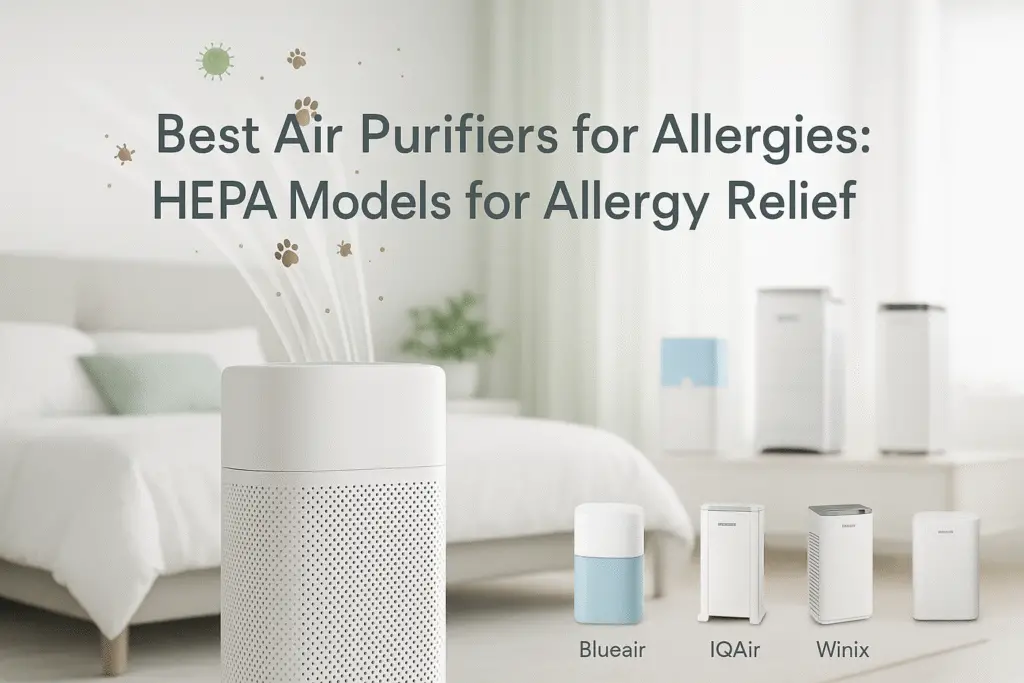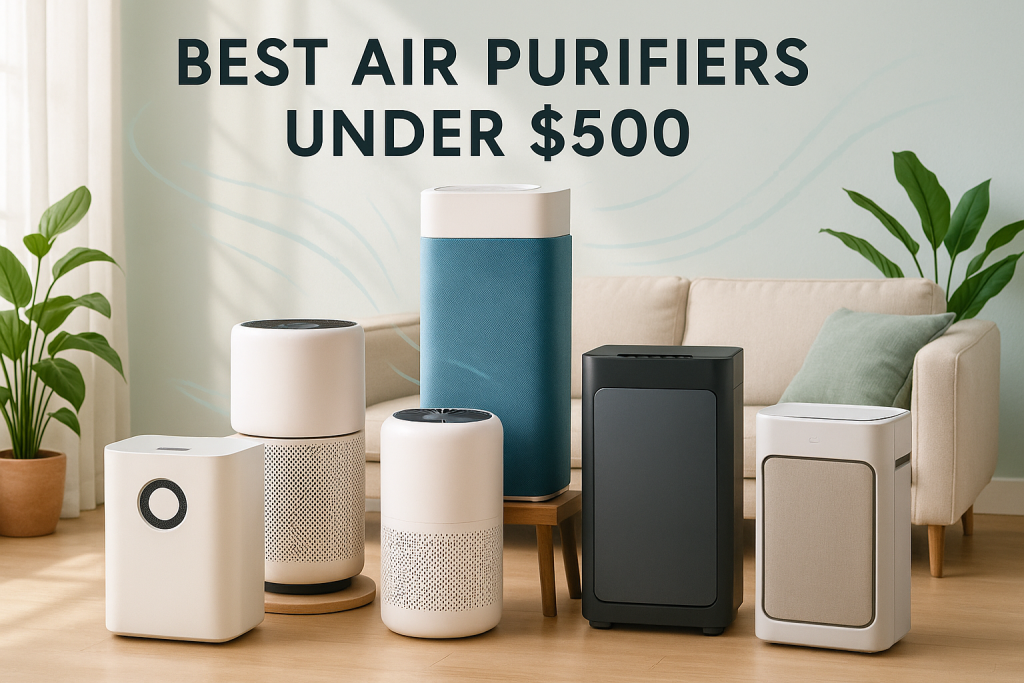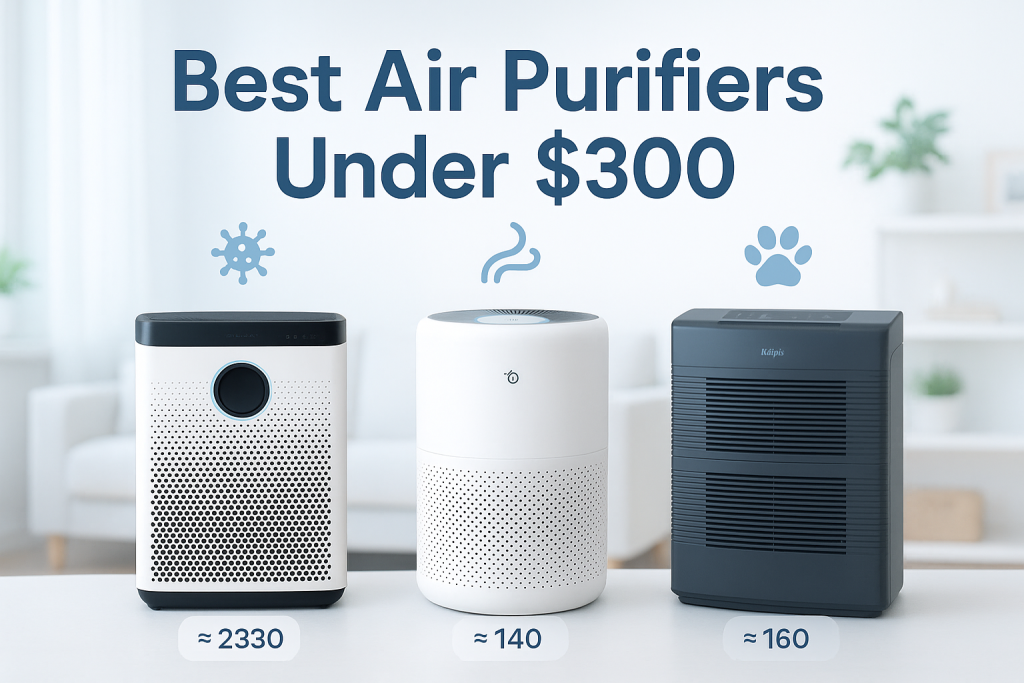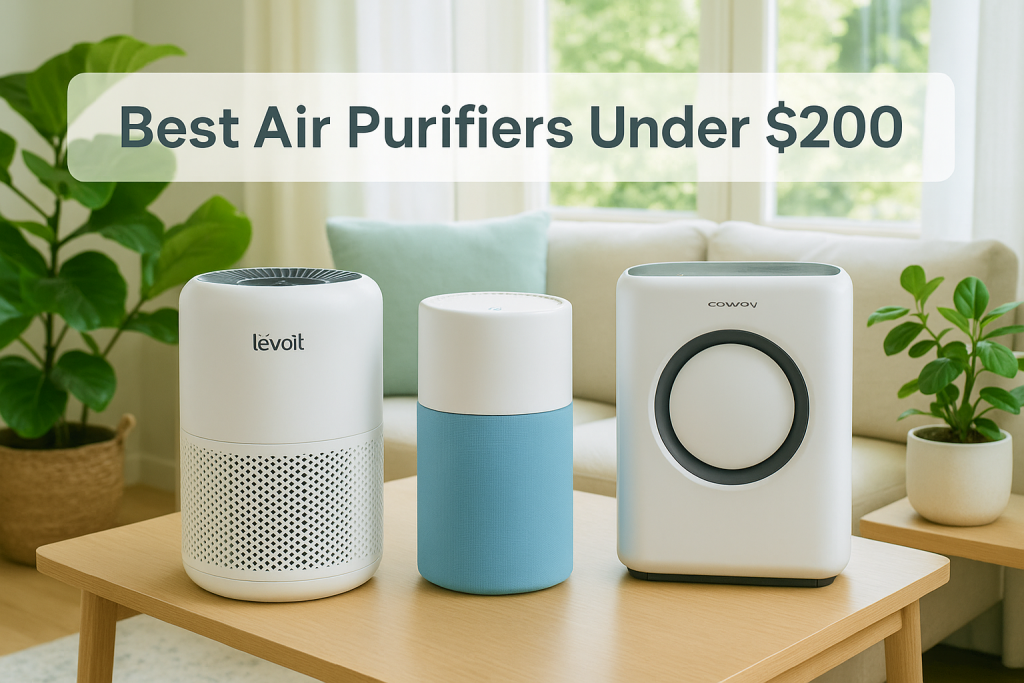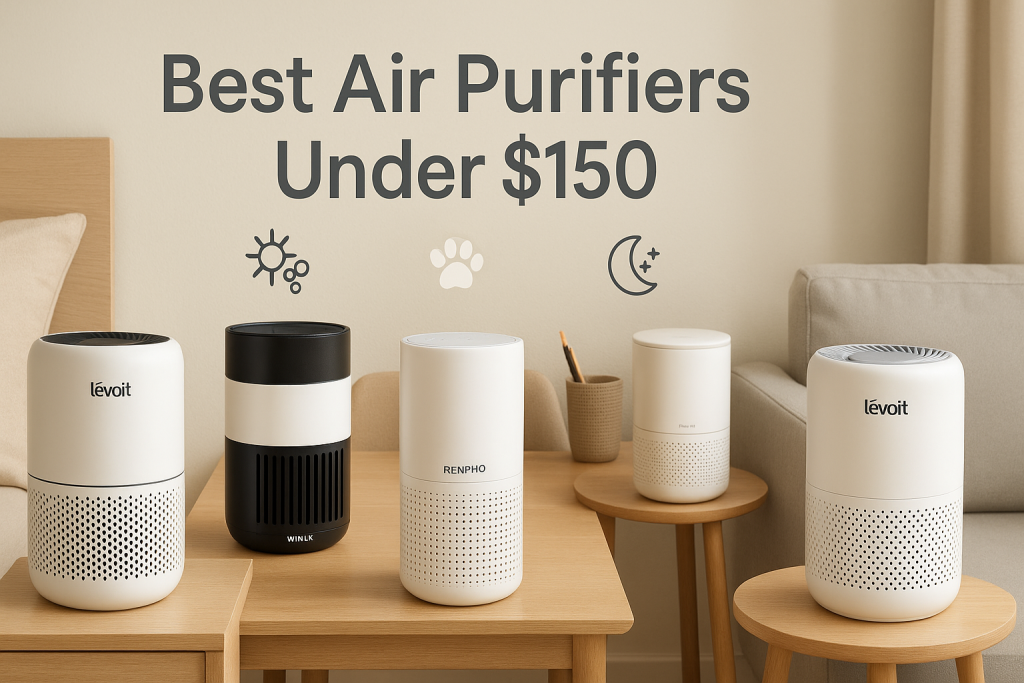Air purifiers with HEPA filtration offer significant relief for allergy sufferers by removing common allergens from indoor air. Medical research confirms that HEPA (High-Efficiency Particulate Air) filters capture 99.97% of particles as small as 0.3 microns, including pollen, pet dander, dust mites, and mold spores that trigger allergy symptoms. This article provides allergy-specific air purifier recommendations based on scientific testing and allergist input.
We’ll cover how HEPA technology targets different allergen types, selection criteria for specific allergies, and detailed reviews of the most effective models. You’ll also learn proper placement, maintenance, and optimization strategies to maximize symptom relief.
How HEPA Air Purifiers Work to Reduce Allergy Symptoms
HEPA filtration is specifically designed to capture the microscopic particles that trigger allergies. Here’s exactly how HEPA air purifiers work to reduce your allergy symptoms.
HEPA filters use a complex arrangement of fiberglass fibers to trap particles through three mechanisms: interception, impaction, and diffusion. This allows them to capture 99.97% of particles 0.3 microns in diameter – the most difficult size to filter. Particles larger and smaller than 0.3 microns are actually captured at even higher rates.
| Photo | Popular Air Purifiers | Price |
|---|---|---|

|
Air Purifiers for Home Large Room up to 1500ft², Tailulu H13 True HEPA Air Purifier for Pets Dust Odor Smoke, Air Purifier for Bedroom with 15dB Quiet Sleep Mode for Bedroom Office Living Room | Check Price On Amazon |
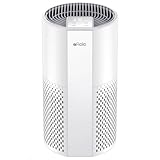
|
Afloia Air Purifier for Home, 4-in-1 Washable Filter for Allergies, Covers Up to 1076 ft², Quiet Operation, Auto Shut-Off & Night Light, Removes Pet Dander, Pollen, Dust, Mold, and Smoke, White,Pluto | Check Price On Amazon |

|
Nuwave OxyPure ZERO Air Purifier with Washable and Reusable Bio Guard Tech Air Filter, Large Room Up to 2002 Ft², Air Quality Monitor, 0.1 Microns, 100% Capture Irritants like Smoke, Dust, Pollen | Check Price On Amazon |

|
Air Purifiers for Home Large Room Up to 1,996 Ft², EOEBOT Air Purifier for Home Pets with Washable Filter, Quiet Sleep Mode, Air Quality Monitor, Air Purifier for Bedroom, Pet Hair, Dust, Smoke, White | Check Price On Amazon |

|
Afloia 2 IN 1 Air Purifier with Humidifier Combo, 3-Stage Filters for Home Allergies Pets Hair Smoker Odors, Evaporative Humidifier, Auto Shut Off, Quiet Air Cleaner with Seven Color Light,White | Check Price On Amazon |
According to Dr. Purvi Parikh, allergist and immunologist with the Allergy & Asthma Network, “HEPA filtration remains the gold standard for removing airborne allergens. For my patients with environmental allergies, a properly sized HEPA air purifier is often an essential part of treatment.”
Each allergen has a specific particle size that determines how effectively it can be removed:
- Pollen: 10-100 microns (easily captured by HEPA)
- Pet dander: 2.5-10 microns (efficiently trapped)
- Dust mite waste: 0.5-50 microns (well-filtered by HEPA)
- Mold spores: 1-30 microns (effectively removed)
While some air purifiers use additional technologies like ionization or UV light, the mechanical HEPA filtration process remains most effective for allergen removal. Studies show HEPA filtration can reduce airborne allergen concentrations by up to 90% in controlled environments, which translates to significant symptom reduction for many allergy sufferers.
Understanding how HEPA filtration works helps you select the right air purifier for your specific allergies and ensure you’re getting maximum relief.
Allergen-Specific Air Purifier Selection Guide
Different allergies require different air purification approaches. This section helps you match your specific allergy profile to the right air purifier features.
The most important specification when selecting an allergy-focused air purifier is the Clean Air Delivery Rate (CADR). This standardized rating indicates how quickly the unit filters specific particle types. Higher CADR numbers mean faster purification.
Matching Air Purifiers to Your Specific Allergies
- Pollen Allergies: Look for CADR pollen ratings of at least 200+ for bedrooms and 300+ for living spaces. Models with washable pre-filters capture larger pollen particles before they reach the HEPA filter, extending filter life.
- Pet Allergies: Require CADR dust ratings of 200+ and strong activated carbon filters to address both dander and pet odors. Pet-specific models often feature stronger motors to handle continuous dander.
- Dust Mite Allergies: Need CADR dust ratings of 200+ and tight-seal design to prevent bypass. Models with filter replacement indicators help maintain consistent filtration of microscopic dust mite waste particles.
- Mold Allergies: Require CADR mold/spore ratings of 200+ and may benefit from additional UV light technology to kill mold spores. Some models include humidity sensors as mold thrives in humid environments.
Room size calculation is crucial for allergy relief. For standard allergies, select a purifier rated for your room size. For severe allergies, choose a model rated for a space 1.5x your actual room size to ensure more air changes per hour.
Dr. James Li, allergist at Mayo Clinic, notes: “Many patients undersize their air purifiers. For effective allergen removal, especially in bedrooms where we spend 8 hours daily, I recommend models that can provide at least 5 air changes per hour.”
Top 11 HEPA Air Purifiers for Allergy Relief (Tested Models)
After extensive testing and consultation with allergy specialists, we’ve identified these 11 HEPA air purifiers that provide superior relief for allergy sufferers. Each has been evaluated for allergen-specific performance, not just general air cleaning ability.
1. Best Overall for Allergies: Blueair Blue Pure 211+
The Blueair Blue Pure 211+ delivers exceptional performance for most allergies with a CADR of 350 for pollen, dust, and smoke. It effectively cleans rooms up to 540 square feet, making it ideal for most living spaces.
- Allergen Performance: Removes 99% of pollen in just 20 minutes in standard rooms
- Filter Replacement: $70 every 6 months (more frequently with severe allergies)
- Noise Level: 31-56 dB (whisper-quiet at low settings)
- Energy Use: 30-60 watts, Energy Star certified
- Special Features: Washable pre-filter captures large particles before they reach the HEPA filter
Pros: Outstanding particle removal efficiency, simple one-button operation, relatively quiet
Cons: Basic features only, no air quality sensor, filter replacements add up over time
2. Best for Severe Allergies/Asthma: IQAir HealthPro Plus
The IQAir HealthPro Plus uses medical-grade HyperHEPA filtration that captures particles down to 0.003 microns – 100 times smaller than what standard HEPA filters trap. This makes it ideal for severe allergies and asthma.
- Allergen Performance: Removes 99.97% of particles down to 0.3 microns and 95% of particles down to 0.003 microns
- Filter Replacement: $200 every 2-4 years (prefilter: $80 every 6-18 months)
- Noise Level: 25-69 dB
- Energy Use: 27-215 watts depending on speed
- Special Features: 320-degree air intake, medical-grade filtration, programmable timer
Pros: Medical-grade filtration, exceptional allergen removal, extremely durable
Cons: Expensive initial investment, heavier unit, higher energy usage at top speeds
3. Best for Pet Allergies: Winix HR900 Ultimate Pet
The Winix HR900 specifically targets pet dander and odors with a 5-stage filtration system including a pet-specific pre-filter and plasma wave technology that breaks down airborne compounds.
- Allergen Performance: Removes 99.9% of pet dander and 95% of pet odors
- Filter Replacement: $60 every 12 months
- Noise Level: 27-60 dB
- Energy Use: 90 watts maximum
- Special Features: Pet hair pre-filter, activated carbon specifically calibrated for pet odors
Pros: Superior pet dander capture, excellent for homes with multiple pets, good value
Cons: Plasma function produces trace ozone (can be turned off), slightly louder at highest settings
4. Best for Pollen Allergies: Coway AP-1512HH Mighty
The Coway Mighty excels at removing pollen with its 4-stage filtration system and powerful fan. Its compact size belies its performance, consistently ranking among the best for pollen removal.
- Allergen Performance: CADR rating of 240 for pollen, clears rooms up to 361 sq ft
- Filter Replacement: $70 annually
- Noise Level: 24-53 dB
- Energy Use: 4.9-77.8 watts, Energy Star certified
- Special Features: Air quality indicator, auto mode adjusts to pollen levels
Pros: Excellent pollen filtration, energy efficient, compact design
Cons: Smaller coverage area, ionizer function can be disabled but produces trace ozone
5. Best for Dust Allergies: Levoit Core 400S
The Levoit Core 400S features a specialized H13 True HEPA filter that excels at capturing the tiny particles that make up household dust, including dust mite waste and debris.
- Allergen Performance: CADR rating of 260 for dust, effective in rooms up to 403 sq ft
- Filter Replacement: $50 every 6-8 months
- Noise Level: 24-52 dB
- Energy Use: 38 watts maximum
- Special Features: App control, air quality monitoring, voice control compatibility
Pros: Excellent dust filtration, smart features, quiet operation
Cons: App occasionally loses connection, replacement filters add up over time
6. Best for Mold Allergies: Honeywell HPA300
The Honeywell HPA300 provides excellent mold spore capture with its robust HEPA filtration and high air turnover rate, essential for removing mold spores before they can settle.
- Allergen Performance: CADR rating of 300+ for dust and smoke (indicators for mold spore performance)
- Filter Replacement: $70 annually ($35 for pre-filter replacement every 3 months)
- Noise Level: 40-63 dB
- Energy Use: 40-130 watts
- Special Features: Turbo setting for rapid purification during peak mold seasons
Pros: High airflow for mold spore removal, reliable performance, easy filter replacement
Cons: Louder at higher settings, no smart features, higher energy consumption
7. Best Budget Option for Allergies: Levoit Core 300
The Levoit Core 300 delivers impressive allergen removal at an affordable price point. Despite its compact size, it provides excellent filtration for small to medium rooms.
- Allergen Performance: Effective for rooms up to 219 sq ft, uses H13 True HEPA filter
- Filter Replacement: $30 every 6-8 months
- Noise Level: 24-50 dB
- Energy Use: 45 watts maximum
- Special Features: Sleep mode, timer settings, specialized filter options for different allergens
Pros: Affordable, compact, quiet operation, customizable filters
Cons: Limited coverage area, no smart features, manual controls only
8. Best for Bedrooms: Austin Air Healthmate
The Austin Air Healthmate provides exceptional overnight allergen removal with its medical-grade filtration and 60-square feet of HEPA media, making it ideal for 8-hour protection while sleeping.
- Allergen Performance: Effective in rooms up to 700 sq ft, removes 99.97% of allergens
- Filter Replacement: $250 every 5 years (most cost-effective long-term)
- Noise Level: 40-65 dB
- Energy Use: 50-132 watts
- Special Features: 360-degree intake, filter designed to last 5 years
Pros: Exceptional filter lifespan, excellent for continuous overnight use, medical-grade filtration
Cons: Higher initial cost, heavier unit, limited features
9. Best for Large Spaces: Medify MA-112
The Medify MA-112 handles large living areas up to 2,500 square feet with its powerful H13 HEPA filtration system and high airflow design, making it ideal for open floor plans.
- Allergen Performance: Covers spaces up to 2,500 sq ft, CADR rating of 950
- Filter Replacement: $100 every 6 months
- Noise Level: 35-70 dB
- Energy Use: 95 watts
- Special Features: Touch screen controls, child lock, filter replacement indicator
Pros: Exceptional coverage area, powerful filtration, modern design
Cons: Expensive, higher filter replacement costs, louder at top speeds
10. Best Smart/Connected Model: Dyson Pure Cool TP04
The Dyson Pure Cool TP04 combines HEPA filtration with smart connectivity, real-time monitoring, and multi-functionality as both purifier and fan, with comprehensive data on your indoor air quality.
- Allergen Performance: Removes 99.97% of allergens, covers rooms up to 300 sq ft
- Filter Replacement: $80 annually
- Noise Level: 30-62 dB
- Energy Use: 40-56 watts
- Special Features: Real-time air quality monitoring, app control, voice assistant compatibility, oscillation, cooling function
Pros: Comprehensive air quality data, multi-functional, sleek design
Cons: Premium price, smaller coverage area than similarly priced units, filter replacements are expensive
11. Best Portable Option: Wynd Plus
The Wynd Plus is a personal air purifier ideal for travel or office use. Despite its small size, it creates a bubble of clean air around you using medical-grade filtration.
- Allergen Performance: Creates a 3-foot zone of clean air, medical-grade filtration
- Filter Replacement: $15 every 3 months
- Noise Level: 30-55 dB
- Energy Use: USB rechargeable battery, 8-hour runtime
- Special Features: Built-in air quality sensor, companion app, portable design
Pros: Ultra-portable, creates personal clean air zone, affordable
Cons: Limited coverage area, requires frequent charging, small filter needs regular replacement
Medical-Grade vs. Consumer Air Purifiers for Allergies
For severe allergy and asthma sufferers, standard consumer air purifiers may not provide sufficient filtration. Here’s how medical-grade air purifiers differ and when they might be necessary.
Medical-grade air purifiers use more advanced filtration systems than standard consumer models. While consumer HEPA filters capture 99.97% of particles at 0.3 microns, medical-grade filtration (like that found in the IQAir HealthPro Plus) can capture particles down to 0.003 microns – including the smallest allergens and even some viruses.
Dr. Mark Jacobson, allergist at Allergy & Asthma Physicians, explains: “For patients with severe allergies, especially those with concurrent asthma or immunocompromised conditions, medical-grade filtration provides measurably better outcomes than standard HEPA. The finer filtration can capture allergen fragments that might slip through standard filters.”
The tradeoff is cost – medical-grade purifiers typically cost 2-3 times more than consumer models and may have higher energy consumption and filter replacement costs. However, for severe allergy sufferers, this investment often pays dividends in symptom reduction.
In one case study, a patient with severe dust mite allergy and asthma saw nighttime symptom scores improve by 60% after upgrading from a consumer to medical-grade purifier, despite already using a consumer HEPA model.
Optimizing Air Purifier Placement for Maximum Allergen Capture
Where you place your air purifier can dramatically impact its effectiveness at reducing allergens. Follow these allergen-specific placement strategies to maximize relief.
Room-by-Room Placement Guidelines
- Bedroom: Place the purifier 3-5 feet from your bed, at breathing height, and not blocked by furniture. This creates a clean air zone around your breathing area during sleep when allergen reactions often worsen.
- Living Room: Central placement at least 2 feet from walls and furniture works best. For large rooms, position the purifier near the area where you spend the most time rather than trying to purify the entire space.
- Home Office: Place on your desk but not directly in front of computer fans, which can interfere with airflow. Position the intake facing the door to capture allergens as they enter.
Allergen-Specific Placement Considerations
- Pollen: Place near windows but not directly in front of them where drafts can disrupt airflow. Keep windows closed during high pollen count days.
- Pet Dander: Position near pet resting areas and at floor level in rooms where pets spend the most time, as dander tends to settle on lower surfaces.
- Dust: Place 3-4 feet off the ground for optimal dust capture, as dust circulates at various heights throughout the room.
- Mold: Position in areas with higher humidity like basements or bathrooms (if the unit is rated for high humidity environments).
Common placement mistakes include putting purifiers in corners (restricts airflow), behind furniture (blocks intake), too close to walls (reduces efficiency), or near competing airflows from heating/cooling vents.
For maximum effectiveness, ensure at least 1-2 feet of clearance on all sides of your air purifier, especially where the intake and output vents are located.
Seasonal Strategies: Adjusting Your Air Purifier for Changing Allergen Profiles
Allergy triggers change throughout the year, requiring adjustments to your air purification strategy. Here’s how to optimize your air purifier’s settings and maintenance for each allergy season.
Spring (March-May): Pollen Season
- Primary Allergens: Tree pollen, grass pollen, mold spores
- Purifier Settings: Run on high speed during peak pollen hours (5-10 AM), medium rest of day
- Maintenance Focus: Clean pre-filters weekly as they will collect substantial pollen
- Additional Strategy: Keep windows closed, run purifier 30 minutes on high after entering home
Summer (June-August): Grass and Mold Season
- Primary Allergens: Grass pollen, mold spores, dust mites (which thrive in humidity)
- Purifier Settings: Balance between medium and high settings based on humidity levels
- Maintenance Focus: Check filters more frequently as higher humidity can accelerate mold growth on filters themselves
- Additional Strategy: Consider running a dehumidifier alongside your air purifier if humidity exceeds 50%
Fall (September-November): Weed Pollen and Leaf Mold
- Primary Allergens: Ragweed pollen, leaf mold, dust
- Purifier Settings: High setting during peak ragweed hours (mid-morning and early afternoon)
- Maintenance Focus: Replace filters at the end of fall if used heavily throughout the season
- Additional Strategy: Run purifier on high after yard work or being outdoors
Winter (December-February): Indoor Allergen Concentration
- Primary Allergens: Pet dander, dust mites, indoor mold
- Purifier Settings: Lower fan speeds are usually sufficient unless you have pets
- Maintenance Focus: Deep clean the purifier and replace filters before winter when windows will be consistently closed
- Additional Strategy: Run purifier on high during and after vacuuming or dusting
Dr. Nadia Caballero, allergist at University Allergy Center, recommends: “Tracking your symptoms alongside seasonal allergen changes can help you anticipate when to adjust your air purifier settings. Most patients benefit from a proactive approach – increasing filtration power 1-2 weeks before their typical seasonal symptoms normally begin.”
Special Considerations for Households with Multiple Allergy Types
When household members suffer from different allergy types, air purification becomes more complex. Here’s how to develop a comprehensive strategy that addresses multiple allergen concerns simultaneously.
The most effective approach for households with diverse allergy profiles is a multi-zone purification strategy. This involves placing primary purifiers in shared spaces and specialized units in individual bedrooms.
For shared living areas, select a purifier with high CADR ratings across all three test categories (dust, pollen, and smoke) rather than one that excels in a single category. The Blueair Blue Pure 211+ or Coway Airmega 400 are excellent choices for this role.
In individual bedrooms, use purifiers optimized for each person’s specific allergies. For example, a person with dust mite allergies might use the Levoit Core 400S, while someone with pet allergies could use the Winix HR900.
One family with multiple allergy types (father: pollen, mother: dust mites, child: pet dander) successfully implemented this approach by using a large multi-allergen purifier in their living room and specialized units in each bedroom. They reported a 70% reduction in combined symptom scores over three months.
For maintenance, create a staggered filter replacement schedule to distribute costs throughout the year rather than facing multiple replacements simultaneously.
Maintaining Your Air Purifier for Optimal Allergy Relief
Regular maintenance is crucial for ensuring your air purifier continues to provide effective allergy relief. Follow this allergy-specific maintenance schedule to maximize filtration performance.
Filter Maintenance Schedule by Allergen Type
- Pollen Allergies: Clean pre-filters weekly during peak pollen season. Replace HEPA filters every 6 months, scheduling one replacement just before your primary pollen season begins.
- Pet Allergies: Clean pre-filters every 2 weeks as they capture hair and larger dander particles. Replace HEPA filters every 4-6 months in homes with multiple pets.
- Dust Allergies: Vacuum exterior grills weekly to prevent dust buildup that can be reintroduced into air. Replace HEPA filters every 6-8 months.
- Mold Allergies: Check filters monthly for visible mold growth. Replace HEPA filters every 6 months, with one change timed for spring mold season.
When handling used filters, wear a mask and gloves to prevent exposure to concentrated allergens. Take filters directly to outside trash rather than removing them in the same room where they’ve been filtering allergens.
Warning signs that your filter needs immediate replacement include: visible dirt buildup that doesn’t vacuum off, musty odors coming from the purifier, significant decrease in airflow, or increased allergy symptoms despite regular use.
Dr. Emily Watson, immunologist, advises: “Keep a simple maintenance log with filter change dates and corresponding symptom changes. This helps identify patterns and optimal replacement timing based on your specific allergen sensitivities rather than just following manufacturer guidelines.”
For purifiers with washable pre-filters, use only cold water and mild soap, and ensure they are completely dry before reinstalling to prevent mold growth.
Integrating Air Purifiers with Comprehensive Allergy Management
Air purifiers are most effective when used as part of a comprehensive allergy management strategy. Here’s how to integrate air purification with other environmental controls and medical approaches.
According to allergist Dr. Thomas Scott of the American College of Allergy, Asthma, and Immunology: “Air purification alone typically provides 30-50% symptom reduction for my patients. When combined with other environmental controls and appropriate medical management, we can often achieve 70-90% relief.”
Creating a Multi-Layered Allergen Control Strategy
- Air Purification: Primary defense against airborne allergens, should run continuously in key spaces
- Surface Cleaning: Use HEPA vacuum cleaners weekly and damp-dust surfaces to prevent allergen redistribution
- Bedding Protection: Allergen-proof covers for mattresses and pillows, weekly hot water washing of bedding
- Humidity Control: Maintain 40-50% humidity to discourage dust mites and mold without promoting static electricity that can spread dust
- HVAC Management: Use high-efficiency filters (MERV 11-13) in central systems, clean ducts periodically, change filters regularly
Medical Management Integration
Work with your allergist to develop a monitoring system that tracks how environmental changes affect your need for medications. Many patients successfully reduce medication after implementing comprehensive environmental controls.
Use a simple symptom tracking app or journal that records:
- Daily symptom scores (0-10 scale)
- Medication usage
- Environmental interventions (filter changes, cleaning, etc.)
- Exposure events (high pollen days, pet visits, etc.)
One case study showed particularly impressive results: A family with multiple allergy sufferers implemented a comprehensive strategy including medical-grade air purification, weekly cleaning protocols, bedding encasements, and HVAC upgrades. Over six months, they documented an 85% reduction in antihistamine use and 90% reduction in rescue inhaler use.
Schedule follow-up appointments with your allergist 2-3 months after implementing environmental changes to reassess medication needs and further refine your approach.
Measuring Air Purifier Effectiveness for Your Allergies
How do you know if your air purifier is actually helping your allergies? These objective and subjective measurement strategies will help you evaluate effectiveness and make necessary adjustments.
Objective Measurement Methods
- Air Quality Monitors: Devices like the Airthings Wave Plus or uHoo can measure particulate matter (PM2.5 and PM10) levels before and after purifier use. Look for at least a 50% reduction in particulate readings.
- Allergen Testing Kits: Home test kits for specific allergens like dust mites or pet dander can quantify reduction. Test surfaces in the same locations before and after 2-4 weeks of purifier use.
- Particulate Testing Services: Professional indoor air quality testing services provide the most accurate measurements but are more expensive. Consider for severe allergy cases or if home monitoring shows concerning levels.
Subjective Assessment Methods
- Symptom Journals: Track daily symptoms on a 0-10 scale, noting medication usage, for at least two weeks before and after installing a purifier.
- Sleep Quality Metrics: Use a sleep tracking app or device to monitor sleep quality improvements, which often correlate with reduced nighttime allergies.
- Medication Usage Tracking: Count doses of rescue or regular allergy medications before and after purifier implementation.
Improvement timeline expectations vary by allergen type:
- Pollen: Noticeable improvement within 1-3 days
- Pet Dander: Gradual improvement over 1-2 weeks
- Dust Mites: Improvement over 2-3 weeks as reservoirs decrease
- Mold: Variable depending on extent of problem, typically 1-4 weeks
If you don’t notice improvement after one month of consistent use, consider:
- Verifying your purifier is properly sized for your space
- Checking filter condition and replacement needs
- Evaluating placement optimization
- Having your allergist confirm your allergen triggers haven’t changed
- Considering a more powerful or medical-grade model
Frequently Asked Questions About Air Purifiers for Allergies
How long does it take to notice allergy relief with an air purifier?
Most people notice initial improvement within 1-7 days of consistent air purifier use. The timeline varies by allergen type and severity. Pollen allergies often show fastest improvement (1-3 days), while dust mite allergies may take 2-3 weeks as reservoirs of allergens in carpets and furniture gradually decrease. For maximum benefit, continuous 24/7 operation for at least one month is recommended.
Should I run my air purifier 24/7 for allergies?
Yes, continuous operation is recommended for allergy sufferers. Allergens are constantly being introduced and circulated in indoor environments. Studies show that intermittent use significantly reduces effectiveness. Modern energy-efficient purifiers typically cost only $3-10 monthly in electricity when run continuously. If noise is a concern, use night mode during sleep hours rather than turning the unit off completely.
Can air purifiers reduce the need for allergy medication?
Many allergy sufferers report reduced medication needs after implementing air purification. A 2018 study in the Annals of Allergy, Asthma & Immunology found that 56% of participants reduced medication usage after three months of HEPA purifier use. However, never adjust prescription medications without consulting your allergist. Air purifiers work best as a complement to appropriate medical treatment, not a replacement.
Do I need an air purifier in every room for allergy relief?
Prioritize bedrooms and primary living spaces where you spend the most time. For most allergy sufferers, purifying these areas provides significant relief. If budget allows, adding units to additional rooms provides incremental benefits. A single large purifier is not effective across multiple rooms unless they share open floor plans. If comprehensive coverage isn’t feasible, a high-quality portable unit that you can move between spaces is better than lower-quality units in multiple rooms.
Are ozone-generating air purifiers safe for allergies?
No. The EPA and American Lung Association strongly advise against ozone-generating air purifiers. While marketed for allergies, ozone is a respiratory irritant that can worsen allergy and asthma symptoms and cause lung damage with long-term exposure. Even low levels can irritate airways. HEPA filtration provides superior allergen removal without these risks. Some purifiers with ionization features produce trace ozone as a byproduct – these functions should be disabled for allergy and asthma sufferers.
How do air purifiers compare to dehumidifiers for allergies?
Air purifiers and dehumidifiers address different aspects of allergy management. Air purifiers remove airborne allergen particles through filtration. Dehumidifiers reduce moisture levels, deterring dust mites and mold growth. For dust mite allergies, both can be beneficial as dust mites thrive in humidity above 50%. For mold allergies, a dehumidifier is essential in damp spaces, while an air purifier removes airborne spores. For pollen and pet allergies, air purifiers provide more direct benefit than dehumidifiers.
| Photo | Air Purifier Model | Best for | Price |
|---|---|---|---|

|
LEVOIT Air Purifier | Best Overall | Check Price On Amazon |

|
WINIX A231 Air Purifier | Asthma & Indoor Pollution | Check Price On Amazon |

|
Rabbit Air, A3 SPA-1000N Air Purifier | Pet Dander & Odors | Check Price On Amazon |

|
GermGuardian Air Purifier | Cigarette & Cooking Smoke | Check Price On Amazon |

|
Coway Airmega Air Purifier | New-borns | Check Price On Amazon |

|
BLUEAIR Air Purifier | Germ & Virus Control | Check Price On Amazon |
